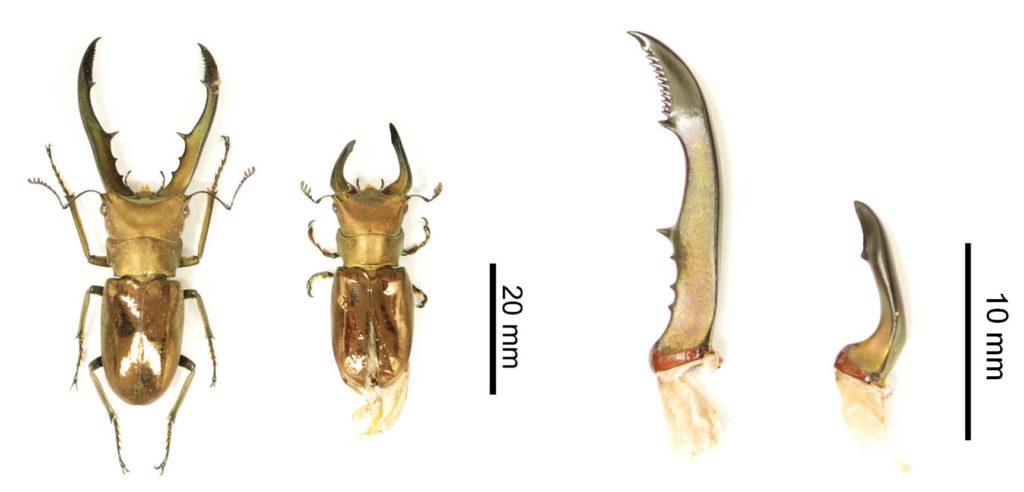Identification of genes controlling mouthpart development – Key to insect diversity
Research Press Release | April 07, 2017
Released by Nagoya University and Hokkaido University
An international research team involving Hokkaido University reveals functions of mouthpart-controlling genes in the development of enlarged mandibles in the stag beetle.

Insects are a biological success story with their high abundance, biodiversity, and almost worldwide distribution. Their evolutionary prowess in part reflects their ability to diversify and fill a variety of ecological niches. One means of doing this is developing a range of mouthparts that enables different foodstuffs to be consumed. Mouthparts can be highly modified, as is the case with the straw-like maxillae of butterflies, or exceptionally enlarged, as is the case with the mandibles of stag beetles that are used for fighting rather than feeding. However, the molecular mechanisms underlying mandible enlargement have been poorly understood. Collaborative research between Japan and the US coordinated by Nagoya University has now shed light on the genetic controls behind stag beetle mandible development. The study was published in Developmental Biology.
The development of appendages, such as limbs and mouthparts, at different distances from the body wall (proximal through medial to distal) is controlled by a series of genes highly conserved among all insects. The researchers used a molecular silencing technique to sequentially knockdown the expression of seven of these genes to investigate their function in the development and enlargement of stag beetle mandibles.
The dachshund (dac) gene, which controls regulation of the middle region of appendages in Drosophila and many other insects, had the greatest effect on the mandible development of all seven genes analyzed.
“Knockdown of dac greatly reduced mandible size in male but not female stag beetles, and affected mandible morphology in both sexes,” corresponding author and former Ph.D. student of Hokkaido University Hiroki Gotoh says: “Knocked-down animals did not develop the serrated teeth normally seen in all males, and also lacked inner teeth characteristics of large males.”
Genes aristaless (al) and homothorax (hth) were also shown to have important roles in the development of the inner teeth. However, knockdown of the Distal-less (Dll) gene, which is functional in distal regions, had no effect on mandible development. This supports previous knowledge that insects lost their most distal mandible regions early in their evolutionary history.
Male-specific mandible enlargement in stag beetles is known to be regulated by juvenile hormones, such that larger males have disproportionately larger mandibles.
“We observed a size-specific link with the functions of dac, al, and hth in the knockdown studies,” Gotoh adds. “This suggests that these genes control their functions using a size-dependent factor – most likely juvenile hormones.”
Genetic silencing also revealed that the seven genes largely controlled stag beetle leg development in a manner highly conserved with that of other insects, but that their roles in antennal formation were more diverse. These conserved developmental functions of some genes but varied roles of others are likely to have contributed to the evolution of mouthparts in different insect species.
Original Article:
Gotoh H. et al., The function of appendage patterning genes in mandible development of the sexually dimorphic stag beetle. Developmental Biology, February 1, 2017.
DOI: 10.1016/j.ydbio.2016.12.011
Funding information:
This work was supported by a Grants-in-Aid for Scientific Research A (No. 25251041) and Challenging Exploratory Research (No. 26650151) from the Ministry of Education, Culture, Sports, Science and Technology of Japan, Grant for basic science research from Sumitomo foundation, and the Japan Society for the Promotion of Science Research Fellowships for Young Scientists.
Contacts:
Designated Assistant Professor Hiroki Gotoh
Graduate School of Bioagricultural Sciences
Nagoya University
Email: h-r-goto[at]ees.hokudai.ac.jp
Professor Toru Miura
Misaki Marine Biological Station
School of Science
The University of Tokyo
Email: miu[at]mmbs.s.u-tokyo.ac.jp
Naoki Namba (Media Officer)
Global Relations Office
Institute for International Collaboration
Hokkaido University
Tel: +81-11-706-8034
Email: pr[at]oia.hokudai.ac.jp
